

8th Grade Assessment Guide for Teachers.pdf. Ohio’s New State Tests: Grade 8 Science Teacher’s Guide General Description of the Grade 8 Science Test 1 In 2010 Ohio adopted new rigorous academic content standards for Grade 8.
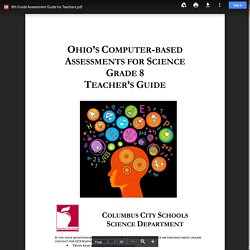
A model curriculum based on these new standards was adopted in 2011. Eighth Grade Cycles and Energy Flow. MS-ESS2-1 Students who demonstrate understanding can: Develop a model to describe the cycling of Earth’s materials and the flow of energy that drives this process.
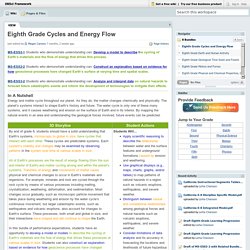
Intro to Eighth Grade. Students in middle school continue to develop understanding of four core ideas in the physical sciences.
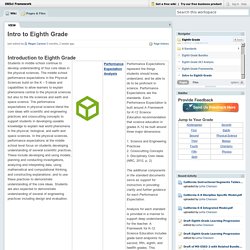
San Francisco Middle School Curriculum. Intro to Sixth Grade. Students in middle school continue to develop understanding of four core ideas in the physical sciences.
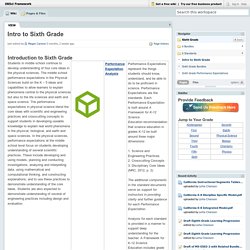
The middle school performance expectations in the Physical Sciences build on the K – 5 ideas and capabilities to allow learners to explain phenomena central to the physical sciences but also to the life sciences and earth and space science. The performance expectations in physical science blend the core ideas with scientific and engineering practices and crosscutting concepts to support students in developing useable knowledge to explain real world phenomena in the physical, biological, and earth and space sciences. In the physical sciences, performance expectations at the middle school level focus on students developing understanding of several scientific practices. Grade 6.pdf. Learning Through Performance - 6th Grade Curriculum. Learning Through Performance - 6th Grade Curriculum. Sixth Grade Forces. MS-PS2-3 Students who demonstrate understanding can: Ask questions about data to determine the factors that affect the strength of electric and magnetic forces.
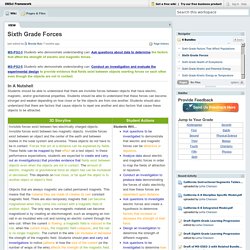
MS-PS2-5 Students who demonstrate understanding can: Conduct an investigation and evaluate the experimental design to provide evidence that fields exist between objects exerting forces on each other even though the objects are not in contact. Students should be able to understand that there are invisible forces between objects that have electric, magnetic, and/or gravitational properties. Students should be able to understand that these forces can become stronger and weaker depending on how close or far the objects are from one another. Grade 7.pdf. Columbus City Schools 2015-2016 2 Revised 2015 Misconceptions -Carleton College provides geology-specific assessment techniques that can identify misconceptions, lists of common Earth science.
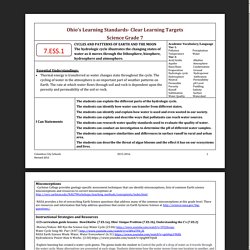
Grade 8.pdf. Curriculum Division / Science Curriculum. American Modeling Teachers Association – Transforming STEM Education. Draft Assessments — The Wonder of Science. Online Courses: Log in to the site. NGSS Integrated Curriculum: An Exploration of a Multidimensional World. Minds-on Activities for Teaching Biology. The resources listed below include: minds-on, hands-on activities and minds-on analysis and discussion activities for teaching biology to high school and middle school students and students in non-major college biology coursesoverviews of important biological topicsgames for learning and review.

Many of these activities are explicitly aligned with the Next Generation Science Standards, as indicated by (NGSS) in the descriptions below and as described in Summary Tables and in the Teacher Notes for individual activities. These activities foster student understanding of Disciplinary Core Ideas, engage students in Scientific Practices, provide the opportunity to discuss Crosscutting Concepts, and prepare students to meet the Performance Expectations of the Next Generation Science Standards. We encourage you to subscribe to our listserv to receive notices when we post new activities or significantly improved versions of current activities. Lesson Plans. Lesson Plans. Kesler Science. Blog Super Secondary collaborators are eager to “thank you…thank you very much…” for ALL that you do to make the world a better place!

So shake, rattle, and roll on Read More Don’t get me started on standardized testing. I’ll save that for another time. Read More General. Documents - Kessler's Science Class. Kesler-Science. I have been a middle school science teacher for 5 years.

I have taught all three grade levels and have loved every minute of it. I am also a host on the www.EduAllStars.com podcast and the genius behind www.geniushour.com I call my teaching style controlled chaos. Interactive-Notebook-Sampler. More resources available through the Science Curriculum Office: Science Songs. Resources for K-12 Education. Search for a specific keyword or choose a subject to filter by : Science Charles Darwin Links Celebrate Charles Darwin's 200th birthday with these educational web sites, classroom activities and lesson plans.

Cheese Science Did you know that there is a lot of science behind cheese? < TinkerBox HD. Engineering - Design a Cell Phone - Teacher's Guide. Activity Home Teacher's Guide Credit & Thanks. Learn Skills. Be Awesome. - DIY. NuSkool. LifeSciTRC.org - Life Science Teaching Resource Community. Astrobiobound. Astrobiobound! NEW - NGSS and CCSS Designed and Aligned! Students learn systems engineering by engaging in a mission planning simulation that mirrors the search for life in our solar system. Students create a mission that has to balance the return of science data with mission limitations such as power, mass and budget.
In this advanced and exciting activity, students in grades 3-12 will become NASA project managers and have the opportunity to plan their own NASA mission. Risk factors play a role and will add to the excitement in this interactive mission planning activity. NIH Curriculum Supplement Series for Middle School - The Science of Healthy Behaviors. NIH Curriculum Supplement Series for Middle School - Doing Science: The Process of Scientific Inquiry. Discover the Creative Engineer in You. Lesson Index. TikLiemScientificInquiry.pdf. Curriculum from the Monterey Bay Aquarium. Teacher Resources, Lessons, Plans, Activities. Intermediate Curriculum Resources.
Intermediate Energy Infobook (e-publication) Energy Infobooks are the resource for many NEED activities and include an introduction to energy, information on major sources of energy, new technologies, energy conservation, electricity, climate change, and other energy information. They are available on four reading levels and are revised and updated annually. Blueprint for Success (e-publication) This essential gusdide helps educators develop effective energy education programs. It provides an outline of a basic energy curriculum unit and matrix of all curriculum options. also included within the Blueprint for Success is a sample work plan and suggestions for energy outreach activities to conduct other classes, schools, families, and communities. the Youth Awards Program Guide and Application Form can also be found in the Blueprint for Success.
Critical Load. Teacher Resources, Lessons, Plans, Activities. Virtual Field Trip-What's the Difference-Moon Math. NASA Wavelength Digital Library. Collaborative Curriculum of AERO Science Teachers. We Read. We Write. We Work. - We Read. We Write. We Work. Browse Lesson Plans. Mr. Parr's Science Songs. Free Teacher Lessons, Common Core Resources. Browse Interactives. Lesson Plans & Resources - Nuclear Science Week. Tesla Town teaches students about electricity system. From nuclear power plants to solar powered homes, TCIPG’s free new iPad app, Tesla Town, allows young students to explore and learn about different energy sources used for electricity production today.
“Most people don’t have a lot of information about where electricity comes from,” said Jana Sebestik, Assistant Director of STEM Curriculum Design for the Office for Mathematics, Science and Technology Education (MSTE) and co-creator of the app. “One of our goals is just to educate people about the various sources.” The Trustworthy Cyber Infrastructure for the Power Grid (TCIPG), a multi-university center administered by Illinois' Information Trust Institute, worked with Sebestik and MSTE to create this interactive application.
The app includes realistic, interactive illustrations of how electricity is produced, such as burning coal to create steam or controlling water flow through a dam. “People see these structures in our cities, but they might not know what they are,” Sebestik said. Engineering Curriculum. Web-based Inquiry Science Environment (WISE) How Do Airplanes Fly 5E. eGFI - For Teachers. Curriculum - Science / Science & Engineering Practices. District Home d. Density Which Graph Is Heavier. Lesson: Free Shot Physics. Basketball not only can be exciting to play or to watch–especially this time of year, when the NCAA college hoops championship known as March Madness tips off. Middle School.